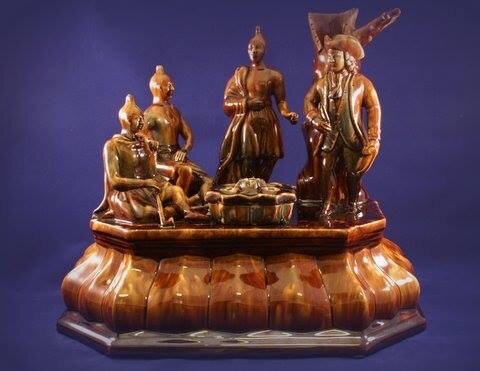
FOR YOUR INFORMATION
FYI
The Mystery of the Inkwell: William Penn and… ?
Benjamin West’s painting “The Treaty of Penn’s with the Indians” was commisioned by Thomas Penn, William Penn;s son. 1771-1772
This inkwell, donated by the Gray family, is exhibited at the Museem of Ceramics.
This Rockingham inkwell, attributed to Harker (possibly Harker and Taylor or Harker and Thompson), ca. 1840s, is a significant addition to the Museum of Ceramics’ collection. Although there are whiteware versions of this inkwell, this is the only known Rockingham piece. It is pristine. Other versions, similar to Greek statues, are missing heads or arms. Even the inkwell insert, a separate piece, is still in place. It is a fine example of some of the earliest ware made by East Liverpool potters.
William and Donna Gray purchased the inkwell from Sotheby’s and donated it to the Museum in 2017. The auction house had labeled the inkwell, “William Penn Treating with the Iroquois Indians,” stating that the dress and hair of the figures were used to determine the tribe designation.
Research by Museum of Ceramics staff has not uncovered any known treaties of Penn with the Iroquois. Historical documents, however, do reveal a very famous treaty between Penn and the Delaware tribe. This historical moment is memorialized in Benjamin West’s painting “The Treaty of Penn’s with the Indians.” It shows William Penn entering into the legendary Treaty of Shackamaxon in 1683 with Tamanend, a chief of the Lenape Turtle Clan of the Delaware tribe. Further consultation with archaeologists at the Ohio History Connection support the theory that it is this treaty that is depicted on the inkwell. The attire of the figures is generic and does not help in identifying the specific tribe. The inkwell is now called “William Penn Treating with the Delaware Indians.”
The treaty was negotiated in what is now Philadelphia. Penn wanted Pennsylvania to be a place where all people lived in peace and as equals He spent a year learning the language of the natives so he could speak directly without interpreters. He was interested in all facets of their lives and attended their councils.
No copy of the treaty exists because Penn’s sons destroyed it and so there is no clear understanding of what the treaty entailed. What is known, is that peace between the Lenape Turtle Clan and Penn’s successors would last for 70 years.

